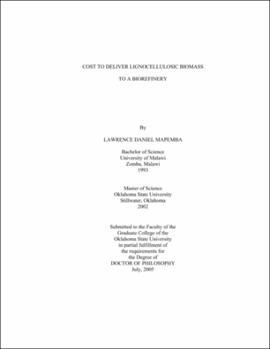| dc.contributor.advisor | Epplin, Francis | |
| dc.contributor.author | Mapemba, Lawrence Daniel | |
| dc.date.accessioned | 2013-11-26T08:22:02Z | |
| dc.date.available | 2013-11-26T08:22:02Z | |
| dc.date.issued | 2005-07 | |
| dc.identifier.uri | https://hdl.handle.net/11244/6525 | |
| dc.description.abstract | Scope and Method of Study: The purpose of this study was to determine the cost to deliver a continuous flow of lignocellulosic biomass (LCB) to a biorefinery that can process 1,000, 2,000 or 4,000 tons of biomass per day. The study also sought to determine how the method of modeling harvest and procurement cost of biomass changes the cost to deliver a steady flow of biomass to a biorefinery. Lignocellulosic biomass includes agricultural residues (e.g. corn stover and wheat straw), herbaceous crops (e.g. alfalfa, switchgrass) and improved pastures (old world bluestem, tall fescue and bermuda grass). A mixed integer mathematical programming model was developed to determine the optimal size and location of a biorefinery, the quantity and types of biomass to be used, sources of biomass feedstock, monthly harvest and storage quantities, number of harvest machines to be used, and the cost to deliver a steady flow of biomass to a biorefinery, among other variables of interest. The base model has more than 403,000 activities in 48,400 equations. | |
| dc.description.abstract | Findings and Conclusions: Based on this study an LCB biorefinery business is expected to develop in concert with well coordinated biomass feedstock harvest units. The harvest units would be managed either by the biorefinery industry itself or by a private company. A total of 26 harvest units at an average investment of $15.34 million would be required to harvest biomass feedstock for a large plant (i.e. plant with capacity to process 4,000 dry tons of biomass per day). These harvest units would result in a per ton harvest cost of $10.72. The biomass industry may use a variety of biomass feedstock species that mature at different periods during the year. In the model total of seven biomass feedstock types were used including wheat straw, corn stover, old world bluestem, bermuda grass, native tall grass, native short grass, and mixed native grass. A variety of biomass feedstock types would result in a harvest season of nine months. This would result in a lower cost to deliver LCB to a biorefinery than a shorter harvest season. Since the plant would operate throughout the year a short harvest season would result in large storage reserves for long periods leading to high storage costs. For the assumptions used it was determined that feedstock would be hauled from an average radius of 106 miles to the biorefinery. | |
| dc.format | application/pdf | |
| dc.language | en_US | |
| dc.rights | Copyright is held by the author who has granted the Oklahoma State University Library the non-exclusive right to share this material in its institutional repository. Contact Digital Library Services at lib-dls@okstate.edu or 405-744-9161 for the permission policy on the use, reproduction or distribution of this material. | |
| dc.title | Cost to deliver lignocellulosic biomass to a biorefinery | |
| dc.contributor.committeeMember | Brorsen, Wade | |
| dc.contributor.committeeMember | Huhnke, Raymond | |
| dc.contributor.committeeMember | Stoecker, Arthur | |
| osu.filename | Mapemba_okstate_0664D_1437.pdf | |
| osu.accesstype | Open Access | |
| dc.type.genre | Dissertation | |
| dc.type.material | Text | |
| thesis.degree.discipline | Agricultural Economics | |
| thesis.degree.grantor | Oklahoma State University | |
